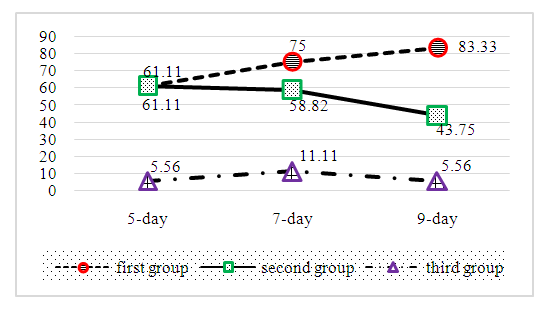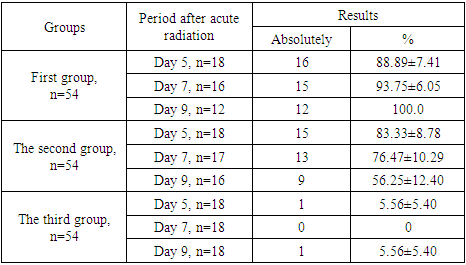-
Paper Information
- Next Paper
- Previous Paper
- Paper Submission
-
Journal Information
- About This Journal
- Editorial Board
- Current Issue
- Archive
- Author Guidelines
- Contact Us
American Journal of Medicine and Medical Sciences
p-ISSN: 2165-901X e-ISSN: 2165-9036
2024; 14(6): 1534-1536
doi:10.5923/j.ajmms.20241406.13
Received: May 21, 2024; Accepted: Jun. 10, 2024; Published: Jun. 13, 2024

Experimental Study of the Degree of Reproduction of Microorganisms Under the Influence of Acute Radiation
Jabborova Oysha Iskandarovna
Bukhara State Medical Institute, Bukhara, Uzbekistan
Correspondence to: Jabborova Oysha Iskandarovna, Bukhara State Medical Institute, Bukhara, Uzbekistan.
Copyright © 2024 The Author(s). Published by Scientific & Academic Publishing.
This work is licensed under the Creative Commons Attribution International License (CC BY).
http://creativecommons.org/licenses/by/4.0/

The main objective of this research work was to determine the percentage of germination of microorganisms translocated from the large intestine to the internal organs. The percentage of microorganisms that passed through the large intestine from the peripheral blood of irradiated laboratory animals increased as the observation period increased. Analysis of the results showed that irradiation increases the permeability of the colon mucosa against the background of general immunodeficiency. In prophylactically biocorrected, irradiated animals, the percentage of germination of microorganisms decreased over time. In both groups, its values were significantly higher than in the control group. The aim of the study was to experimentally study the degree of occurrence of microorganisms that provide the phenomenon of bacterial translocation in the dynamics of observation under the influence of acute irradiation.
Keywords: Microorganism, Immune system, Translocation, Bacteriological examination, Biocorrection, Parameter, Microflora, Laboratory animals, Immunodeficiency
Cite this paper: Jabborova Oysha Iskandarovna, Experimental Study of the Degree of Reproduction of Microorganisms Under the Influence of Acute Radiation, American Journal of Medicine and Medical Sciences, Vol. 14 No. 6, 2024, pp. 1534-1536. doi: 10.5923/j.ajmms.20241406.13.
1. Introduction
- Activity, used as an indicator of the amount of radionuclide present, is expressed in units called becquerels (Bq): one becquerel is one act of decay per second. The half-life is the time required for the activity of a radionuclide to decay to half its original value. [1] The half-life of a radioactive element is the time during which half of its atoms decay. It can range from fractions of a second to millions of years (e.g., the half-life of iodine-131 is 8 days and the half-life of carbon-14 is 5,730 years). Humans are exposed to natural and artificial radiation every day. Natural radiation has many sources, including more than 60 naturally occurring radioactive substances present in soil, water, and air. The main source of natural radiation is radon, a natural gas released from rocks and soil. Radionuclides are inhaled daily by humans from the air and enter the digestive tract with food and water. [2] Humans are also exposed to natural cosmic ray radiation, especially at high altitudes. On average, 80% of the annual dose that humans receive from background radiation comes from natural terrestrial and cosmic ray sources. Levels of such radiation vary in different geographical areas and in some areas can be 200 times higher than the global average. The effects of visible light are responsible for less than 1% of fatal injuries (80% of fatal injuries are attributable to light of wavelengths less than 312 nm). Visible light of 450 nm wavelength induces base pair substitutions and frameshift mutations in E. coli. Light wavelengths of 550 nm and especially 410 nm induce photolysis of Myxococcus xanthus. The effect is determined by the absorption of light by iron porphyrins [3]. These effects are determined by the fact that in bacteria an unusual base 4-thiouridine is present in t-RNA in the 8th position (absent in eukaryotes). This base absorbs UV intensively, with the greatest effect being produced by light with a wavelength of 340 nm. Excited by light, 4-thiouridine binds to cytosine located at the 13th position in t-RNA, which prevents t-RNA from binding to amino acids and therefore leads to suspension of protein synthesis [6].At relatively high doses of near-UV, mutagenic and lethal effects. DNA damage is caused not so much by the UV rays themselves, but by other molecules excited by the light. The absorption of near-UV by 4-thiouridine also plays a role in these effects. The mutagenic and lethal effects depend on the presence of oxygen. Lethal effects are associated not only with DNA damage, but also with damage to membranes (their transport systems) [5].The purpose of the study was to experimentally study the degree of encounter of microorganisms that provide the phenomenon of bacterial translocation in the observation dynamics under the influence of acute radiation. The main task of this research work was to determine the percentage of germination of microorganisms translocated from the large intestine to internal organs.
2. Research Material and Method
- Since the main task in this research work is to determine the percentage of microorganisms translocated from the large intestine to internal organs, only the genera of microorganisms capable of translocation were identified - Escherichia spp, Proteus spp, Staphylococcus spp, Enterococcus spp, Bacteroides spp Acute irradiation of laboratory animals was carried out using the γ-therapeutic apparatus AGAT-R1 (Estonia, 1991), where the radiation source was So-60.
3. Research Results
- White mice that received acute radiation were kept on a common vivarium diet until the 5th day, group 2 laboratory animals were treated prophylactically with "Lactopropolis-AWL" produced in our country from the day of irradiation. Group 1 and 3 animals were kept only on vivarium diet. In the experiment, the percentage of microorganisms translocated from the large intestine to the mesenteric lymph nodes of laboratory animals was different from each other in all three groups (table 1).
|
 | Figure 1. Indicators of the percentage of germination of microorganisms translocated from the colon to the peripheral blood, % |
4. Conclusions
- Thus, the percentage of microorganisms passing through the colon from the peripheral blood of irradiated laboratory animals increased as the observation period increased. In prophylactically biocorrected, irradiated animals, the percentage of microorganism germination decreased over time. In both groups, its values were significantly higher than those in the control group.
 Abstract
Abstract Reference
Reference Full-Text PDF
Full-Text PDF Full-text HTML
Full-text HTML